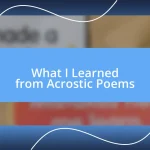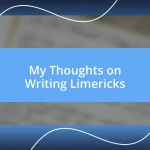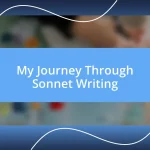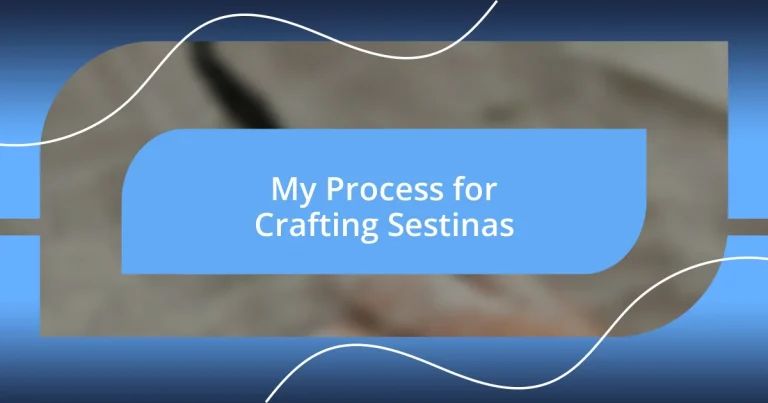Key takeaways:
- The sestina’s unique structure fosters creativity and invites deep emotional exploration through its repetitive patterns and strategic word choices.
- Choosing end words is crucial; they should resonate personally, relate to varied themes, and have sound and imagery potential to enhance the poem’s emotional impact.
- Editing and sharing work allows for growth; feedback helps uncover new dimensions in writing, enriching the poem and fostering a sense of community among poets.
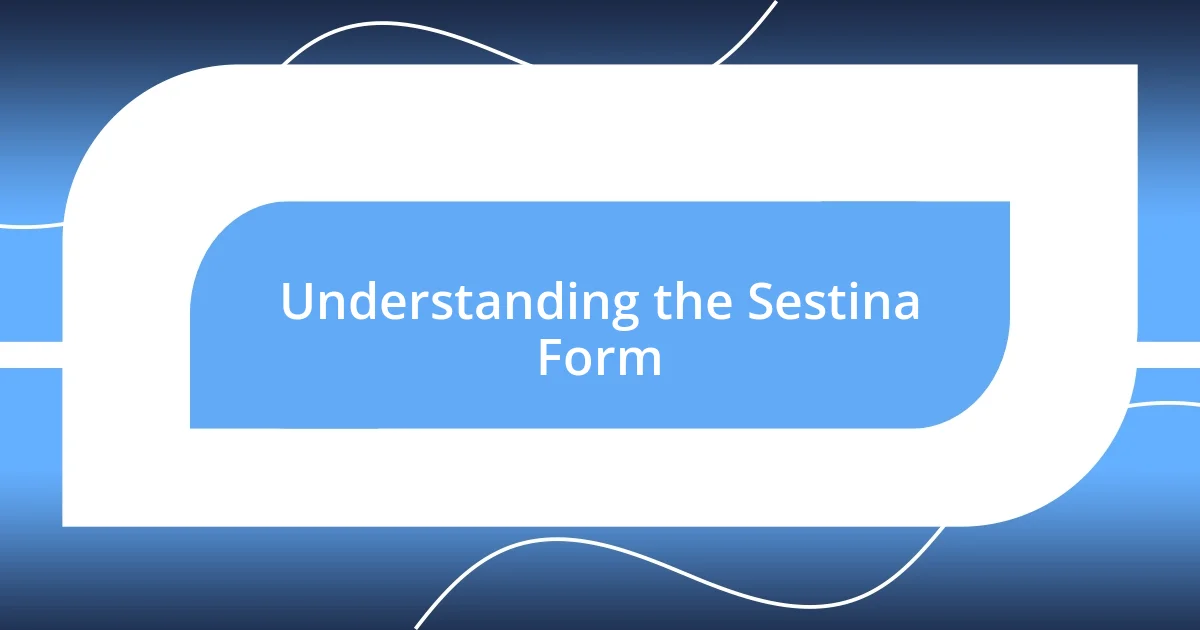
Understanding the Sestina Form
The sestina is a fascinating poetic form that consists of six stanzas, each with six lines, followed by a three-line envoi, or tercet. What draws me to this structure is its intricate pattern of word repetition, where the end words of the first stanza cycle through the following stanzas in a specific order. Have you ever felt the challenge of using the same words repeatedly, yet making each use feel fresh and full of meaning? It’s a delightful puzzle that encourages deep reflection and creativity.
I remember the first time I attempted to write a sestina; I was both excited and intimidated. The idea of crafting a poem that is methodically structured yet emotionally resonant seemed like an uphill battle. Yet, when I finally found my rhythm, weaving together personal experiences with the required words, I discovered a depth of connection that transformed the process into a rewarding experience.
Understanding the constraints of the sestina can initially feel like a limitation, but I’ve found it fosters a unique creativity that often yields unexpected insights. For example, as I played with the end words, I suddenly noticed connections between themes in my life that I hadn’t recognized before. What if these repetitive patterns could reveal something about our own journeys? This process not only challenges our writing skills but invites a deeper exploration of our emotions and thoughts.
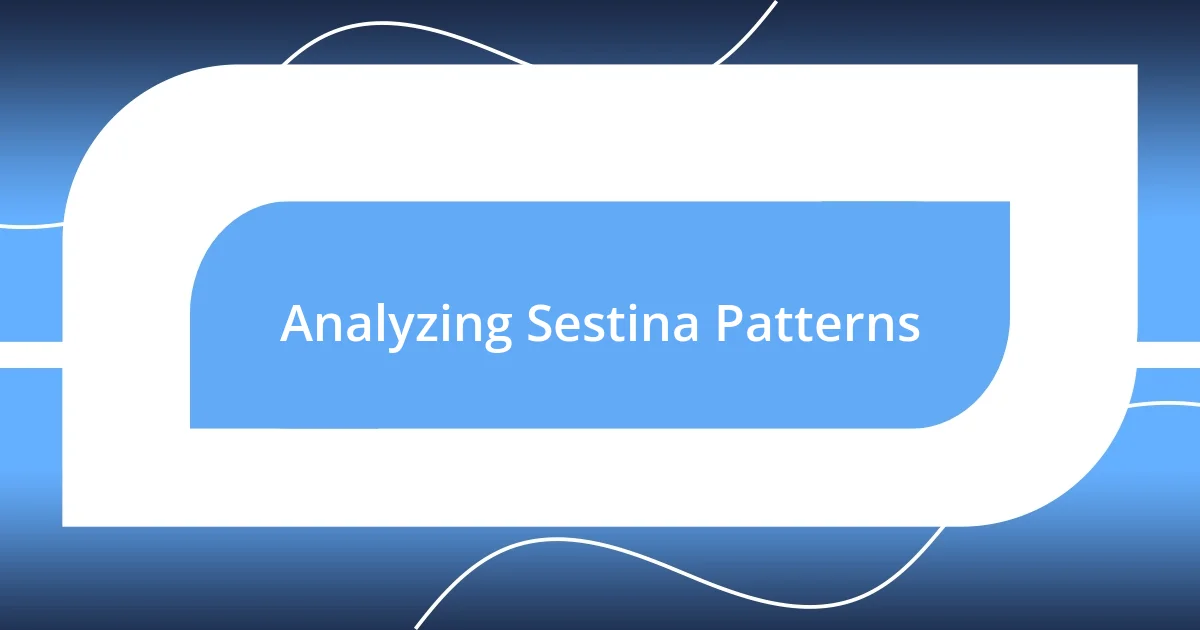
Analyzing Sestina Patterns
When analyzing the patterns of a sestina, it’s fascinating to see how the end words are not just arbitrary choices but strategic selections that weave meaning throughout the stanzas. Each repetition takes on new significance as the poem unfolds, much like how a theme in a song can resonate differently with each chorus. I remember selecting my end words for my first sestina; I chose words that carried a lot of personal weight, and as I wrote, I found that their repeated use transformed them into anchors for my emotions.
The sequence of end words follows a precise yet flexible pattern, which can sometimes feel restrictive but ultimately guides the creative process. It’s like a structured dance where every step is mapped out, yet within those steps lies the opportunity for personal expression. When delving into my own poems, I noticed that by changing just one end word or its position, the entire tone could shift dramatically, revealing layers of meaning I hadn’t anticipated at the outset.
This pattern analysis is not merely an academic exercise; it can unlock deeper truths about our experiences. I’ve often found that re-examining the order of my end words led to surprising revelations. Have you ever had an experience where looking at something from a different angle suddenly illuminated an entirely new perspective? For me, it was in discovering how a single word’s connotation could shift the overall narrative of my poem. By wrestling with these relationships, I’ve learned that the beauty of a sestina lies not just in its form but in the emotional tapestry it allows us to create.
| End Word Position | Example Pattern |
|---|---|
| 1 | A |
| 2 | B |
| 3 | C |
| 4 | A |
| 5 | B |
| 6 | C |
| Envoi | Incorporates All End Words |

Choosing Your Sestina Words
Choosing the right words for your sestina is a crucial step that can deeply influence the emotional impact of your poem. I often find myself reflecting on my own experiences when picking these words. Think about words that resonate with your life or elicit strong emotions. During my last workshop, I chose words like “memory,” “ocean,” and “freedom.” Each time I reached for those words, I felt different layers of meaning unfold. It was eye-opening to see how these selected words began to steer the themes of my poem almost organically.
When selecting your end words, consider these tips:
- Personal Connection: Choose words that evoke significant memories or feelings for you.
- Varied Themes: Opt for words that can relate to different aspects of your theme, allowing for varied interpretations.
- Sound Quality: Pay attention to how the words sound together; rhythm can enhance meaning.
- Imagery Potential: Select words that can create vivid images in the reader’s mind, boosting engagement.
- Flexibility: Don’t hesitate to experiment; sometimes an unexpected choice can yield surprising insights.
The process of choosing your end words is more than just an initial decision; it’s a journey of discovery. There’s something profoundly satisfying about revisiting those choices, knowing that with each line, they’ll evolve and deepen in their significance. Recalling my first attempt at this, I wasn’t just creating a poem; I was unearthing parts of myself I didn’t know were there. That realization can be incredibly powerful.
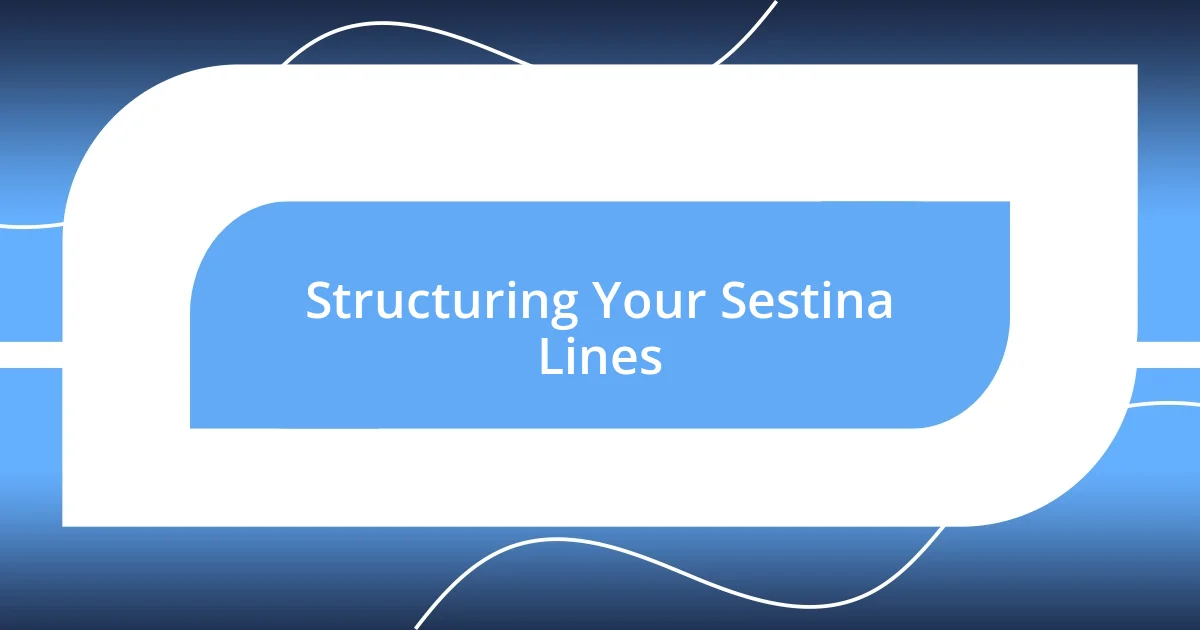
Structuring Your Sestina Lines
Structuring your sestina lines is fundamental to achieving the rhythmic and emotional resonance that makes this form so captivating. I often think of the sestina as a puzzle. When I first attempted one, I laid out my end words in front of me, tracing their connections like a map. This helped me visualize how the lines would interweave, giving each stanza a unique but cohesive identity. Have you ever felt that rush of creativity when you align your thoughts just right? For me, it was like finding the perfect note in a melody, a thrilling moment where everything clicked.
As you craft each stanza, remember that this isn’t just about repetition; it’s about transformation. Each time you introduce an end word, consider how its context shifts. One of my favorite moments came while writing about “light.” In the first stanza, it symbolized hope, but by the end, it took on a more reflective tone, hinting at loss. I couldn’t help but wonder: how many layers can a single word hold? This dynamic layering is where the true magic of a sestina lies, and with every line, you breathe new life into your already chosen words.
It’s also vital to keep an ear tuned to the cadence of your lines. The rhythm can change with the arrangement of words. I recall a sestina where I deliberately altered line breaks to heighten the anticipation. It felt exhilarating to see how those changes shifted the poem’s energy, pulling readers along for the ride. So, how can you play with structure in your own work? Experiment with enjambment or punctuation – sometimes a small tweak can open up a whole new dimension in your poem.
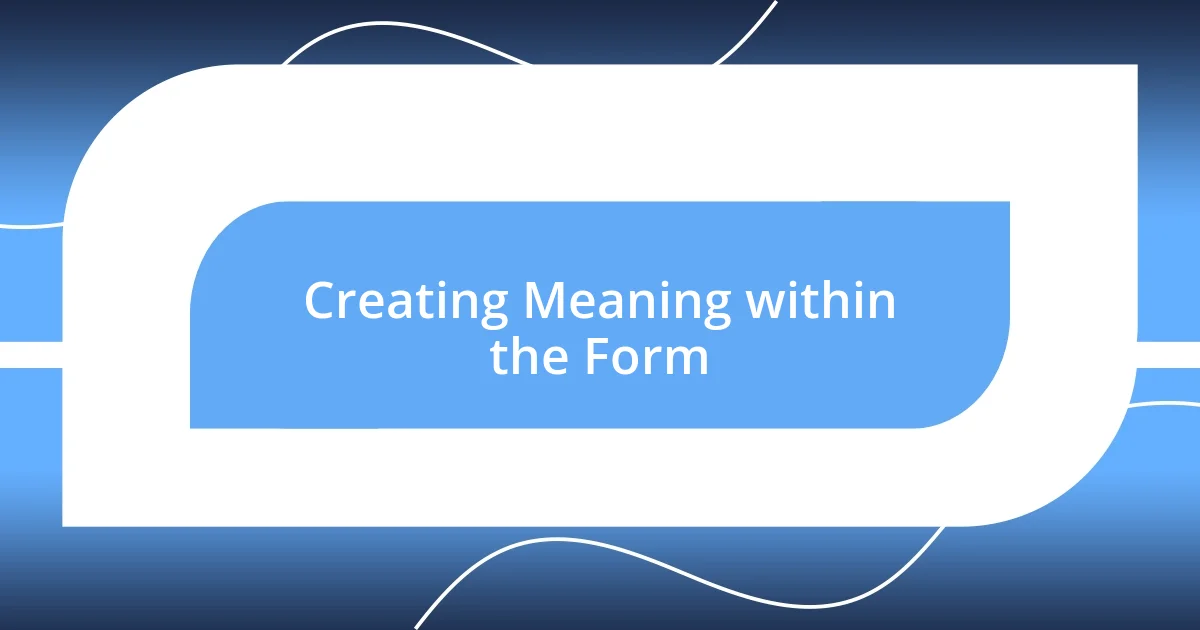
Creating Meaning within the Form
Creating meaning within the structured form of a sestina is a process rich with nuance. I remember grappling with my first sestina and feeling somewhat lost in the repetitive nature of the layout. However, the moment I embraced that repetition as an opportunity to deepen meaning, everything changed. Instead of merely recycling words, I began to think of how each word could evolve through the emotional lens of the stanzas. Reflecting on this shift made me realize that the form itself can serve as a powerful catalyst for exploration.
As the end words loop through the stanzas, they can subtly shift their connotations, revealing layers I never anticipated. One of my most memorable experiences was with the word “shadow.” Initially, it represented safety, but as the poem progressed, it morphed into a symbol of haunting memories. Have you ever had a single word carry you through a journey like that? It’s fascinating how a tailored structure can prompt such significant transformations, deepening both the text and its emotional heartbeat.
Embracing the limitations of the form allowed me to channel my experiences more effectively. I recall a particular sestina where I was struggling to convey a sense of longing. In that instance, I discovered that the intentional placement of my end words could amplify that feeling, creating a resonant echo that captured my own nostalgic sentiments. It led me to wonder: how might the boundaries of a form actually push us towards creating more profound meanings? I truly believe that in the midst of these constraints lies the potential for richer emotional truths.
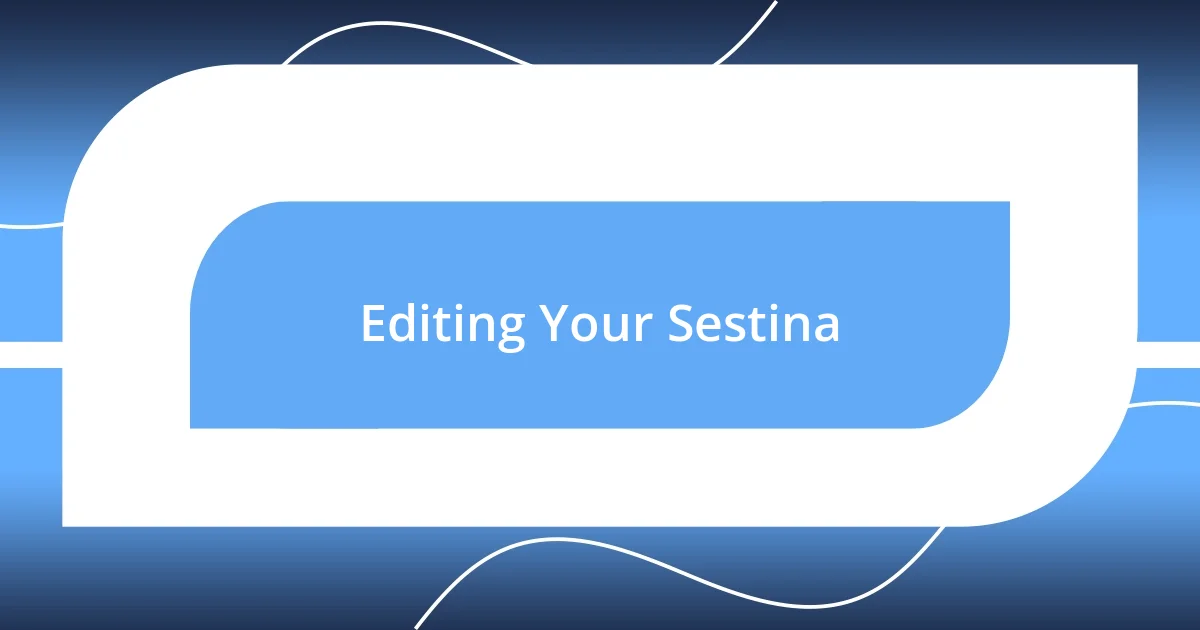
Editing Your Sestina
When I approach the editing stage of my sestina, I find it’s essential to step back and view the work with fresh eyes. I often print out the poem and read it aloud, allowing the sound and rhythm to guide my revisions. Have you tried this technique? There’s something about hearing the words that reveals little hiccups or awkward phrases I might miss on the page. It’s like taking a step onto a stage before the curtain lifts; I want to ensure every line captivates the audience.
As I sift through each stanza, I look for where the meaning shifts and evolves—a critical element in a sestina. I once edited a piece where a single line felt overstuffed with imagery, diluting its impact. By choosing to trim down the description, letting the end word “water” flow more freely, the poem transformed. Each verse became more resonant, and the emotionally charged imagery shone through. Can you relate to the challenge of knowing when to pull back? It’s a delicate dance between abundance and clarity that helps sharpen the poem’s emotional focus.
Finally, I consider how the end words play off one another throughout the poem. An editor’s eye can reveal connections I hadn’t consciously made during the initial writing phase. I recall a moment in my editing process where I realized two end words had a familial relationship, creating a deeper resonance when placed in proximity. It made me wonder: what stories lie in the juxtaposition of your chosen words? Highlighting these interactions can truly elevate the piece, leading readers to an unexpected, interconnected journey.
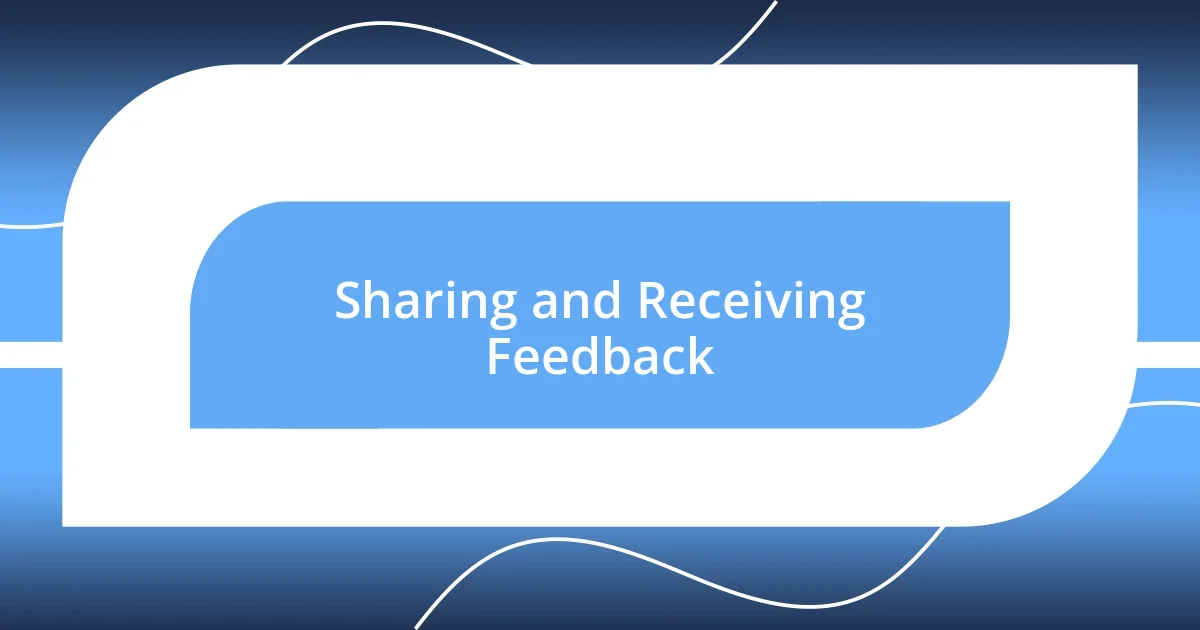
Sharing and Receiving Feedback
Engaging in the sharing and receiving of feedback can be an enlightening component of crafting a sestina. I remember a workshop session where I nervously presented my poem. Listening to others dissect my work was initially daunting. Yet, their insights unveiled blind spots I hadn’t noticed, revealing new pathways for emotional depth that I had overlooked. How often have you found a single comment to be a turning point for your own writing?
In my experience, constructive criticism can feel like a treasure hunt. One time, a peer pointed out that my word choices fell flat in a particular stanza. Instead of feeling defensive, I leaned into that feedback, exploring synonyms that might evoke stronger imagery. Have you felt like a poem could transform with just one or two alterations? This back-and-forth exchange fosters growth, allowing us to unearth layers within our work that we couldn’t see alone.
Ultimately, feedback is not just about critique; it’s about building a community around shared passion. I recall the joy of returning to my poem after receiving notes and finding it richer, more nuanced. When we open ourselves to others’ perspectives, we not only enhance our sestinas but also connect more deeply with the collective experience of crafting poetry. Isn’t it interesting how collaboration can spark creativity in ways we never anticipated?
